
Racquet stringing is a vital component to a player’s tennis game. It is no wonder that professionals have multiple racquets in their bags with a fresh set of strings. There is now a greater selection of strings than ever before and yet it is still overlooked by the casual tennis player.
Our customers often spend weeks and months trying to figure out which racquet will suit their game best. It is equally as important to speak with our Master Racquet Technicians to explain to you the different strings you can choose from to compliment your racquet and style of game. The strings in your racquet make up 50% of the playability of a racquet and factors such as wrong string, wrong tension or just not stringing your racquet frequently enough can turn the once perfect racquet into something unplayable.
To learn more about how often you should re-string your racquet check out our other blog titled “How Often Should You Re-String Your Racquet”.
Factors Affecting All Strings
Gauge

Gauge is defined by the thickness of the string, which can vary from brand to brand. It is important to know the actual diameter of the string to better understand the impact it has. A thinner string will provide more power and enhance spin while thicker strings provide more control. Furthermore a thinner string is less durable in comparison to a thicker string due to there being less material to wear through and the added friction provided by the added movement.
Tension

The most common analogy used to better understand tension is to compare it to a trampoline. Simply put, a higher tension should provide you with more control while a lower tension should provide you with more power. This is due to string bed deflection, a string bed with lower tension can deflect and transfer more energy back to the ball when the string snaps back to its starting position.
String Types

To better understand the different varieties of string that are available we will explain the four main types of string. Each string has unique characteristics and suits differing styles of play.
Natural gut
First made by Babolat in 1875, natural gut is the original tennis string. The string is made from the intestines of specific types of cow from specific parts of the world. The best thing about these strings is their elasticity. It provides a level of comfort, power and tension maintenance that is unmatched by any other type of string on the market.
The one aspect where you can run into some issues with natural gut is the level of durability. If you play with lots of spin, your strings move on your string bed causing friction. This friction is one of the main reasons for natural gut strings breaking. Natural gut is also more affected by damp conditions.
However, despite its high price point, if you don’t break strings over a long period of time it is probably the most cost effective choice as there is less need to restring it because of its excellent tension maintenance.
Target Player
Players who suffer from arm injuries (tennis elbow) would benefit most from a natural gut string. A flat hitter who plays with little spin allows for more durability.
| Pros | Cons |
|---|---|
| Very Comfortable | Durability |
| Enlarges Sweet Spot | High Price Point |
| Excellent Tension Maintenance |
Check out our full selection of natural gut strings, below you will find our most popular ones:
| Luxilon Natural Gut | Babolat VS Touch |
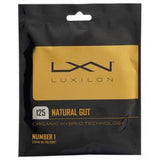 |
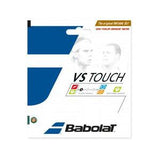 |
Multifilament
Multifilament strings were designed to replicate natural gut strings. They are made from thousands of tiny fibres woven together, only instead of using cow intestines, a high grade of nylon is used.
Multifilament strings have improved greatly over the years and, whilst nothing can compete with natural gut, they are being used more and more frequently by players who are looking for similar characteristics to natural gut without the high cost. In fact, even a hand full of top professional players are using multifilaments instead of gut as part of their hybrid string set ups.
Target Player
Players who suffer from arm injuries (tennis elbow) and are looking for something more durable than a natural gut string.
| Pros | Cons |
|---|---|
| Comfortable | Durability |
| Cost Effective | |
| Good Tension Maintenance |
Check out our full selection of multifilament strings, below you will find our most popular ones:
| Wilson NXT | Technifibre X-One |
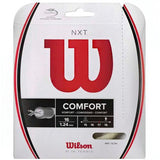 |
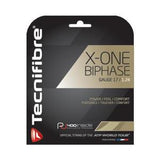 |
Synthetic Gut/Wrap Strings
Synthetic gut strings are constructed with a monofilament core and a multifilament wrap around it. They, like multifilament strings, are made of nylon, but usually of a lower grade / quality.
They can be found with either one or two multifilament wraps. For example Babolat produce a standard synthetic gut which has a single wrap, but they also have a synthetic gut called Powergy which has two wraps. The more wraps you add the more comfort you should feel.
They are generally seen as good all around strings, they provide a bit of everything – softer than polyester, more durable than multifilament – but without having any standout qualities.
Target Player
Juniors who break multifilament strings often. Those new to the game, players not sure of what they are looking for.
| Pros | Cons |
|---|---|
| Low Price Point | Average Characteristics |
Check out our full selection of synthetic gut strings, below you will find our most popular ones:
| Head Syn Gut PPS | Babolat Powergy |
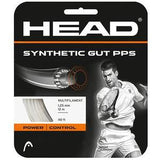 |
 |
Polyester
Polyester strings have garnered lots of attention over the recent years. Most professional players use either a full bed of polyester strings or a hybrid with a softer string. They are constructed of a single strand of polyester offering the greatest level of durability and control due to its stiffness.
However, due to the stiffness of the string, it does not reduce any of the vibration from impact and can lead to arm issues if not maintained and used properly. Polyester strings also lack in tension maintenance as they lose tension quickly, that is why many professional players who use poly strings request their racquet to be re-strung even if they didn’t use it and the number of racquets being strung at top level tournaments are increasing year on year. They have durability but no longevity, essentially all playability is lost after 6-10 hours of play.
*It is advised to string polyester strings 10% lower tension than other strings.
Side Note: We do not recommend polyester strings to junior players as they can have a negative impact on the player. As juniors develop and grow they are exerting lots of effort and putting lots of stress on their bodies just by playing the game. Using a polyester string adds to that stress and there is no actual benefit due to junior players as they are not strong enough to move the strings.
Target Player
Professional players, heavy spin hitters who break strings very often.
| Pros | Cons |
|---|---|
| Excellent Control | Poor Tension Maintanence |
|
Durability |
Stiffness |
Check out our full selection of polyester strings, below you will find our most popular ones:
| Luxilon Alu Power | Babolat RPM Blast Rough |
 |
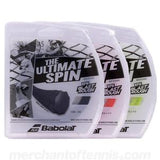 |
Hybrid Stringing
Hybrid stringing is when players use two different strings, one in the mains and one in the crosses. Traditionally a polyester was used in the main (vertical) strings and a softer string in the crosses (horizontal). The goal is to provide a greater level of durability without having to deal with a full bed of poly.
Recently there has been a trend to reverse the hybrid by putting the softer string in the mains and the polyester in the crosses. The goal was to provide more comfort and feel compared to the traditional hybrid set up. This new method may sacrifice a little bit of durability, but is still significantly longer lasting than a full multifilament or natural gut string bed.
Target Player
Competitive players looking for best of both worlds by combining two different string compositions.
| Pros | Cons |
|---|---|
| Durable | Stiffer than full multifilament/gut |
| Not as harsh as full polyester | |






